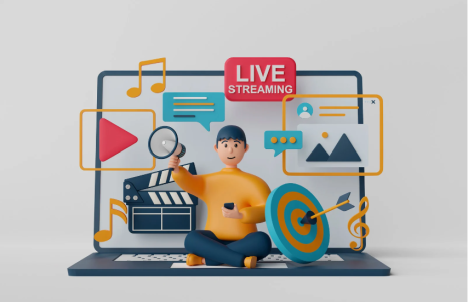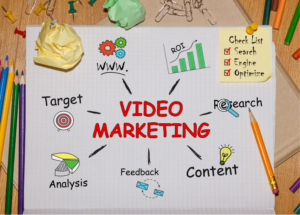In today’s digital age, B2B video marketing has become one of the most powerful and influential mediums in digital advertising. The transformative power of visual storytelling has redefined how businesses connect with their target audience, fostering engagement and bolstering brand visibility.
While video marketing has long been popular in the B2C sector, staying ahead in the B2B sector requires embracing dynamic strategies that resonate with modern audiences. Its importance and effectiveness in B2B marketing cannot be underestimated.
In this blog post, we will delve into the remarkable rise of B2B video marketing and how it plays a role in driving successful marketing campaigns, while uncovering the myriad of benefits it brings, from increased engagement to improved SEO.
If you’re ready to elevate your marketing efforts and captivate your B2B audience, read on to discover the incredible potential of B2B video marketing in the world of digital advertising!
. . .
Contents
- The Benefits of B2B Video Marketing
- Types of B2B Marketing Videos
- Crafting Compelling Video Content
- Distributing & Promoting Your Video Marketing Content
- Measuring & Analyzing the Success of Your Marketing Videos
- Arising Challenges & Solutions When Pursuing B2B Video Marketing
- Future Trends in B2B Video Marketing
- Conclusion
. . .
The Benefits of B2B Video Marketing

B2B video marketing has become an increasingly popular and effective marketing channel for businesses to reach and engage with their target audience. In today’s digital age, where video content is highly consumed on a daily basis, businesses can leverage the power of video to effectively communicate their message, showcase their products or services, and build brand awareness.
According to Forbes, “Wyzowl’s 2023 State of Video Marketing report found that businesses are responding to audience preferences, with 91% leveraging video as a marketing tool this year, an all-time high.” Additionally, the global media company states that “96% of marketers reported that video is an ‘important part’ of their marketing strategy, as 92% said that video provides a positive ROI, driving sales, understanding of products or services, and brand awareness.”
Key Benefits of B2B Video Marketing
Incorporating video marketing into your B2B digital marketing strategy can yield a multitude of benefits, contributing to the overall success and effectiveness of your campaigns. Here are 9 key advantages for adopting a B2B video marketing strategy:
- Increased Engagement & Retention: Videos capture and retain audience attention more effectively than text or static images. Engaging visuals and storytelling can make complex B2B messages more digestible and memorable.
- Enhanced Brand Awareness: Video content is highly shareable, making it a potent tool for increasing brand visibility. Social media platforms, in particular, provide a vast landscape for your videos to be discovered and shared by a broader audience.
- Improved SEO & Website Traffic: Search engines prioritize video content, and incorporating videos on your website can enhance your SEO efforts. This, in turn, drives more organic traffic to your site, as search engines recognize the value and relevance of multimedia content.
- Demonstrating Product or Service Value: Videos allow you to showcase your products or services in action, providing demonstrations that effectively communicate their value proposition. This can be especially impactful for B2B companies with complex or innovative offerings.
- Building Trust & Credibility: Video content, particularly customer testimonials and case studies, can build trust by offering real-world examples of successful partnerships. Seeing and hearing satisfied clients adds a human touch, fostering credibility in the eyes of potential customers.
- Global Reach & Accessibility: With the rise of online platforms and social media, videos can be easily shared and accessed globally. This facilitates reaching a wider audience, including international markets, without significant logistical challenges.
- Flexibility in Content Types: B2B video marketing encompasses various formats such as explainer videos, product demonstrations, webinars, and thought leadership pieces. This versatility allows you to tailor content to different stages of the buyer’s journey.
- Personalization & Relationship Building: Videos enable a more personal connection with your audience. Whether through personalized messages or behind-the-scenes glimpses of your company culture, video content helps humanize your brand and foster stronger relationships with clients and prospects.
- Measurable Impact: Digital platforms provide robust analytics, allowing you to measure the performance of your video content. Key performance indicators (KPIs) such as views, engagement rates, and conversion metrics provide valuable insights for refining and optimizing your strategy.
By embracing B2B video marketing, businesses can tap into a dynamic and engaging medium that not only sets them apart in a crowded digital landscape but also drives tangible results across various aspects of their marketing efforts.
Types of B2B Marketing Videos

There are various types of B2B marketing videos that businesses can utilize to effectively communicate their message and showcase their products or services. These videos come in various formats, each serving a specific purpose in the buyer’s journey and marketing strategy.
By incorporating different types of videos into their B2B marketing strategy, businesses can effectively reach their target audience, drive conversions, and ultimately grow their business. Here are 10 of the most common types of B2B marketing videos:
- Explainer Videos: Concise videos that explain a product or service, focusing on its key features and benefits. These are particularly effective for introducing complex or innovative solutions.
- Product Demonstrations: Videos that showcase how a product works in action. These can highlight specific features, demonstrate use cases, and provide a hands-on view of the product’s functionality.
- Customer Testimonials: Videos featuring satisfied customers sharing their positive experiences with your product or service. Testimonials add authenticity and build trust by showcasing real-world success stories.
- Webinars & Live Streams: Live, interactive video sessions that allow businesses to present information, host Q&A sessions, and engage with their audience in real time. Webinars are valuable for thought leadership and educating prospects.
- Company Culture & Behind-the-Scenes: Videos that offer a glimpse into the inner workings of your company, showcasing your culture, values, and the people behind the brand. This humanizes the business and establishes a connection with the audience.
- Industry Insights & Thought Leadership: Videos where experts share insights, trends, and thought leadership within a specific industry. Establishing your company as an authority can attract and engage prospects interested in staying informed.
- Tutorial & How-To Videos: Educational videos that guide users through specific tasks or processes related to your product or industry. These videos provide value to your audience and position your brand as an informative resource.
- Case Studies: In-depth videos that detail a specific customer’s journey, challenges faced, and how your product or service addressed those challenges. Case studies provide evidence of your solution’s effectiveness.
- Event Highlights: Videos capturing key moments from industry events, conferences, or trade shows where your company participated. This can include interviews, product launches, and highlights from presentations.
- FAQs & Answer Videos: Videos that address frequently asked questions about your product or service. Providing clear answers can help prospects make informed decisions and overcome potential barriers.
Choosing the right type of B2B marketing video depends on your specific goals, target audience, and the stage of the buyer’s journey you aim to address. Incorporating a mix of these video types into your strategy can create a well-rounded and compelling content portfolio.
Crafting Compelling Video Content

Video marketing has become an integral part of successful B2B strategies. With attention spans getting shorter, businesses need to capture and hold the attention of their audience. Crafting compelling B2B video marketing content allows businesses to engage, educate, and convert their target audience.
By leveraging the power of visuals, storytelling, and informative content, B2B businesses can create impactful videos that resonate with their audience, showcasing their expertise and ultimately driving more conversions. Here are 11 key steps to help you create compelling B2B video marketing content:
- Understand Your Audience: Begin by gaining a deep understanding of your target audience, including their pain points, challenges, and preferences. Tailor your video content to address their specific needs and interests.
- Set Clear Objectives & Goals: Define the purpose of your video, whether it’s to increase brand awareness, generate leads, showcase a product, or educate your audience. Clearly outlined objectives will guide the content creation process.
- Storytelling & Scriptwriting: Develop a well-structured script that tells a relatable story, addresses challenges, and positions your product or service as the solution. Engage viewers emotionally by using clear and concise language to emphasize the value your offering brings.
- Visual & Audio Quality: Invest in high-quality visuals and audio. Clear, crisp visuals and professional audio contribute to a positive viewer experience. Poor production quality can detract from your message and brand credibility.
- Video Length & Format: Be mindful of your audience’s attention span. While the ideal video length may vary, aim to convey your message efficiently. Consider using different formats such as short-form videos for social media and longer-form content for webinars.
- Add a Call to Action (CTA): Clearly state the desired action you want viewers to take after watching the video. Whether it’s visiting your website, signing up for a webinar, or contacting your sales team, a strong and relevant CTA is essential for driving engagement.
- Personalization: Whenever possible, personalize your video content to make it more relevant to individual viewers. Address specific pain points or challenges your audience may be facing, showing that you understand their unique needs.
- Align with the Buyer’s Journey: Tailor your videos to different stages of the buyer’s journey. Create awareness-focused videos for the top of the funnel, educational content for the consideration stage, and product-focused content for the decision stage.
- Iterate & Optimize: Use analytics to measure the performance of your videos. Analyze key metrics such as views, engagement, and conversion rates. Use insights to iterate and optimize future content, ensuring continuous improvement.
- Highlight Customer Success Stories: Incorporate customer testimonials and success stories into your video content. Real-world examples add credibility and help potential customers envision the value your product or service can bring to their business.
- Keep Up with Trends: Stay informed about the latest video marketing trends and technologies. Experiment with new formats, styles, and platforms to keep your content fresh and aligned with evolving audience preferences.
By combining these elements, you can create B2B video marketing content that captivates your audience, communicates your brand’s value proposition effectively, and drives meaningful engagement and conversions.
Distributing & Promoting Your Video Marketing Content

Effectively distributing and promoting your B2B video marketing content is crucial to reaching your target audience and maximizing its impact. Here are 10 strategies to distribute and promote your B2B video content:
- Leverage Social Media Platforms: Share your videos on popular social media channels relevant to your B2B audience, such as LinkedIn, Twitter, and YouTube. Craft compelling captions and use relevant hashtags to increase visibility.
- Email Marketing Campaigns: Embed videos in your email campaigns to increase engagement. Consider using thumbnail images with a play button to entice recipients to click and watch.
- Optimize Video SEO: Optimize your videos for search engines by using relevant keywords in titles, descriptions, and tags. This can improve your video’s visibility on platforms like YouTube and Google.
- Host Webinars & Virtual Events: Promote your video content through webinars and virtual events. This allows for live interaction with your audience and provides opportunities for Q&A sessions.
- Paid Advertising & Sponsorships: Invest in paid advertising on platforms like LinkedIn or YouTube to target specific B2B audiences. Additionally, explore sponsorships with industry influencers or relevant websites to expand your reach.
- Collaborate with Influencers or Partners: Partner with influencers or other businesses in your industry to co-create and share video content. This can help tap into their existing audience and build credibility.
- Create Teasers & Trailers: Generate excitement by creating teaser videos or trailers that provide a glimpse of the full content. Share these snippets across your social media channels to build anticipation.
- Embed Videos on Your Website: Ensure that your website features a dedicated section for video content. Embed videos on relevant product or service pages to provide additional context and engage website visitors.
- Share on Industry Forums & Communities: Participate in industry forums, discussion groups, and online communities where your target audience congregates. Share your videos when they provide valuable insights or solutions to common challenges.
- Repurpose Content Across Channels: Adapt your video content into different formats (e.g. blog posts, infographics, etc.) to diversify your content marketing efforts and reach audiences across various channels.
By employing a multi-channel distribution strategy and utilizing a mix of organic and paid promotion methods, you can maximize the visibility and impact of your B2B video marketing content.
Measuring & Analyzing the Success of Your Marketing Videos

Tracking and analyzing the success of your B2B marketing videos is crucial for understanding their impact and optimizing future campaigns. By utilizing various metrics and analytics tools, you can gain valuable insights into viewer engagement, conversion rates, and overall performance.
Additionally, analyzing data on viewer behavior and preferences can help you refine your targeting, messaging, and video content to better resonate with your B2B audience. With a data-driven approach, you can ensure that your marketing videos are driving the desired results and maximizing your return on investment (ROI).
Here are 10 steps to effectively measure and analyze the success of your B2B marketing videos:
- Define Key Metrics: Clearly identify the KPIs that align with your video marketing goals. Common KPIs include views, engagement rates, click-through rates, conversion rates, and social shares.
- Use Video Analytics Tools: Leverage video analytics tools provided by platforms such as YouTube, Vimeo, or social media channels. These tools offer insights into viewership, watch time, demographics, and engagement metrics.
- Track Conversions: Monitor the impact of your videos on lead generation and conversions. Track how many viewers take desired actions, such as filling out a form, downloading a resource, or making a purchase, after watching your video.
- Analyze Audience Retention: Assess audience retention metrics to understand at which points viewers drop off. This insight helps identify elements that may need improvement and optimize future video content.
- Engagement Metrics: Evaluate engagement metrics like likes, comments, and shares on social media platforms. High engagement indicates that your content is resonating with your audience.
- Click-Through Rates (CTRs): Measure the CTRs for any embedded links or CTAs within your videos. This helps determine how effective your videos are at driving viewers to take the next step in the buyer’s journey.
- A/B Testing: Conduct A/B testing on different elements of your videos, such as thumbnails, titles, or calls to action. Analyze which variations perform better and apply those insights to future content.
- Survey & Feedback: Collect direct feedback from your audience through surveys or comments. Understand their preferences, gather insights, and use this information to refine your video strategy.
- Integration with CRM Systems: Integrate video analytics with your Customer Relationship Management (CRM) system to track how video engagement correlates with lead nurturing and customer retention.
- Benchmark Against Industry Standards: Compare your video performance against industry benchmarks to understand how well your content is performing relative to others in your sector.
By systematically and continuously analyzing these metrics and insights, you can gain a comprehensive understanding of the success of your B2B marketing videos and refine your approach to achieve even better results in the future.
Arising Challenges & Solutions When Pursuing B2B Video Marketing

Embarking on a B2B video marketing journey is a strategic move that holds immense potential for businesses, yet it comes with its unique set of challenges. Staying ahead requires not only understanding the power of video but also navigating the obstacles that may arise.
Here are some arising challenges and solutions to navigate them:
- Budget Constraints:
- Challenge: Limited resources may hinder the production of high-quality video content.
- Solution: Prioritize content that aligns with key objectives, consider outsourcing for cost-effective production, and leverage user-generated content.
- Challenge: Limited resources may hinder the production of high-quality video content.
- Compliance & Regulatory Issues:
- Challenge: Industries with strict regulations may face obstacles in creating and distributing video content.
- Solution: Thoroughly research and understand industry regulations, work closely with legal teams, and consider alternative content formats that comply with guidelines.
- Challenge: Industries with strict regulations may face obstacles in creating and distributing video content.
- Limited Internal Expertise:
- Challenge: Lack of in-house expertise in video production and marketing.
- Solution: Train internal teams, collaborate with external experts or agencies, and invest in professional development to build in-house capabilities.
- Challenge: Lack of in-house expertise in video production and marketing.
- Overcoming Audience Fragmentation:
- Challenge: B2B audiences are diverse, making it challenging to create content that resonates universally.
- Solution: Conduct thorough audience research, create segmented content for specific buyer personas, and tailor messages to address the unique needs of different segments.
- Challenge: B2B audiences are diverse, making it challenging to create content that resonates universally.
- Measuring ROI:
- Challenge: Determining the return on investment for video marketing efforts can be challenging.
- Solution: Establish clear KPIs, use analytics tools to track performance, and correlate video engagement with lead generation and conversions.
- Challenge: Determining the return on investment for video marketing efforts can be challenging.
- Adapting to Evolving Trends:
- Challenge: Staying current with rapidly evolving video trends can be challenging.
- Solution: Regularly update skills, stay informed about industry trends, and be open to experimenting with new video formats and platforms.
- Challenge: Staying current with rapidly evolving video trends can be challenging.
- Ensuring Accessibility:
- Challenge: Ensuring that video content is accessible to a diverse audience, including those with disabilities.
- Solution: Include captions, and transcripts, and ensure compatibility with screen readers to make your video content inclusive and compliant with accessibility standards.
- Challenge: Ensuring that video content is accessible to a diverse audience, including those with disabilities.
- Securing Executive Buy-In:
- Challenge: Gaining support from executives who may not fully understand the value of video marketing.
- Solution: Develop a compelling business case, showcase successful case studies, and highlight the impact of video on brand awareness, lead generation, and revenue.
- Challenge: Gaining support from executives who may not fully understand the value of video marketing.
- Balancing Quantity & Quality:
- Challenge: Striking a balance between producing a sufficient volume of content and maintaining high quality.
- Solution: Prioritize quality over quantity, repurpose successful content, and develop a content calendar to ensure a steady but manageable flow.
- Challenge: Striking a balance between producing a sufficient volume of content and maintaining high quality.
- Staying Consistent with Brand Messaging:
- Challenge: Ensuring that video content aligns consistently with the overall brand message.
- Solution: Develop a comprehensive style guide, maintain a cohesive brand narrative, and involve key stakeholders in the content creation process to ensure alignment.
- Challenge: Ensuring that video content aligns consistently with the overall brand message.
By addressing these challenges with strategic solutions, businesses can unlock the full potential of B2B video marketing, fostering engagement, building brand authority, and driving meaningful results.
Future Trends in B2B Video Marketing

Anticipating and adapting to emerging trends is essential for staying ahead of the competition. As technology continues to advance and consumer behavior evolves, the future of B2B video marketing holds exciting possibilities.
This exploration into the upcoming trends aims to shed light on the innovative strategies and technological advancements that will shape the landscape of B2B video marketing. Several key trends are expected to shape the landscape:
- Interactive Video Experiences: Interactive elements within videos, such as clickable hotspots, quizzes, and polls, will become more prevalent, fostering greater engagement and participation from viewers.
- AI Personalization: Artificial Intelligence (AI) will play a pivotal role in tailoring video content to individual preferences. Smart algorithms will analyze data to deliver personalized video experiences, enhancing relevance and impact.
- 360-Degree Videos & Virtual Reality (VR): Immersive experiences through 360-degree videos and VR will gain prominence, providing B2B audiences with virtual tours, product demonstrations, and interactive storytelling.
- Short-Form Video Dominance: The popularity of short-form video content, driven by platforms like TikTok and Instagram Reels, will influence B2B marketing. Condensed, impactful videos will be essential for capturing attention in a fast-paced digital environment.
- Livestreaming & Webinars: The continued rise of live video, including webinars and virtual events, will persist, allowing businesses to connect with audiences in real time, fostering engagement and authenticity.
- Shoppable Videos: Integrating e-commerce directly into videos will become more prevalent, allowing B2B audiences to make purchases or inquiries without leaving the video environment.
- Human-Centric Storytelling: Emphasis on human-centric storytelling will continue, with B2B brands showcasing authentic narratives that resonate emotionally with their audience, building trust and connection.
- Augmented Reality (AR): AR features in videos will provide an interactive and enhanced user experience, allowing B2B audiences to visualize products in real-world scenarios or access additional information seamlessly.
- Data-Driven Content Decisions: Advanced analytics and data insights will play a crucial role in content creation. B2B marketers will leverage data to inform decisions, understand audience behavior, and optimize video strategies.
- Environmental, Social, & Governance (ESG) Focus: B2B video content will increasingly reflect a commitment to environmental sustainability, social responsibility, and good governance, aligning with growing corporate responsibility trends.
Adapting to these future trends in B2B video marketing will be instrumental for businesses seeking to maintain a competitive edge, foster meaningful connections with their audience, and drive successful marketing campaigns in the evolving digital landscape.
. . .
Conclusion
The transformative influence of B2B video marketing has emerged as a catalyst for success. It has the power (and will continue) to revolutionize the way businesses connect with their target audience and drive success.
By implementing effective strategies, such as creating engaging and informative videos, optimizing for search engines, and utilizing social media platforms, businesses can harness the power of B2B video marketing to build brand awareness, generate leads, and increase conversions.
With the ever-increasing demand for video content in today’s digital age, incorporating video marketing into your B2B strategy is essential for staying ahead of the competition and achieving long-term success. So, tap into the power of B2B video marketing and propel your business toward greater success!
. . .
If you enjoyed reading content like this, feel free to check out the other blogs on our website. For more information on how to create a powerful B2B video marketing strategy, you can reach out to us for a free consultation. We’d love to get you started on your Synthesis Insights journey today!




